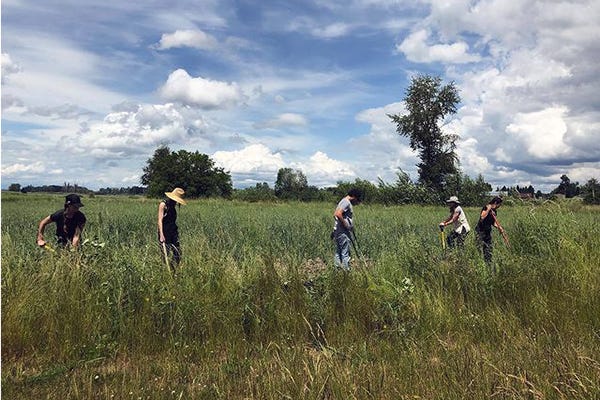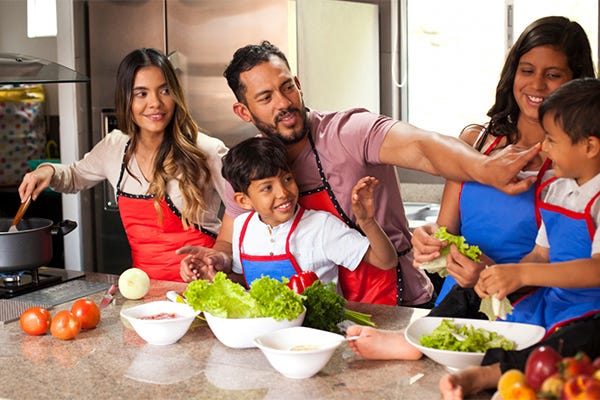Collaborative Effort
Redefining Meaningful Work
Labor Day, the holiday on the first Monday of September honoring the dignity of the American worker, coincides with the unofficial end of summer. Collaborative work almost always refers to teamwork in the context of what we do for a living (a quick search on Google confirms this). Yet, I have witnessed the most purposeful and connected kinds of working together in our chosen communities outside of the workplace.
In my research of vibrant communities, collaborative work was not one of the core qualities I listed in my book, yet it is something that they all had in common. I'm using the word “work” to mean collaborative effort on any project, and this includes a great variety of activities.
One community I spent time with was a female-owned herbal farm, and the collective work of tending to and learning from plants was part of daily life. For another community, work meant service, gathering several times a year to paint murals, pick up trash, or build playgrounds. For another community, collaborative work might be planning a special birthday celebration for someone.
In general, vibrant communities find it essential to show up and work together. They may spend less time in ways that many consider socializing, such as going to a restaurant, a movie, or engaging in some other form of entertainment. That doesn't mean they don't do these things too, but gathering in a way that relies on their combined, collaborative efforts is central to their bonds.
In vibrant communities, the primary purpose of collaboration is not necessarily the outcome of the shared goal, but rather the process of working together as a form of connection. Work is a way to highlight different people's strengths and capacities, for learning new skills, and for putting effort towards shared values. Collaborative work is not primarily a means to an end, such as earning money (although important); it is instead a way to be in a relationship.
The same vibrant communities that spend time working together also make time to celebrate together. The celebrations are more meaningful because of the shared effort that members make.
Jennifer Marie Serna, the owner of Wapato Island Farm on Sauvie Island in Portland, Oregon, believes hard work is an honor. As a healer who uses plant medicine, she is grateful to her ancestors for giving her the skills to work and to listen to the plants. Whether working or playing together, there is always engagement and an opportunity for relationship and trust-building. For Jennifer and the other farmers, this includes relationships with people, plants, and the natural world. Jennifer also loves to hear live music and go dancing, making room for it all!
Vibrant communities have in common that they prioritize celebration and ritual. Often, these are directly related or come out of working together. An example of this on Wapato Island Farm is the act of bottling medicine from harvested plants. People from several communities arrive early in the day for conversation and a shared meal. When the farmers are ready for the medicinal tinctures to be bottled, the women and their daughters leave the gatherings and come together in the event space named “Abuela Tecolate”. Conversation and music permeate the large, open-air room as the women fill bottles. The atmosphere combines work, friendship, and connection. It is both festive and reverent; one doesn't preclude the other.
This collaborative effort is central to the growing movement of community-based sustainable food systems, which are more agile and can adapt to the needs of the local communities. They foster trusting relationships and celebrate traditional wisdom and ways to be more responsible stewards of the land. In these movements, there is a commitment to the communities near the farm, especially those with less access to healthy food.
When did we start defining work almost exclusively as something we do for a living? This delineation has had the unfortunate outcome of diminishing the value of critical, life-enhancing work like mothering and parenting, caretaking, volunteering, growing a garden, showing up for our elders, being an elder, learning different languages, and any effort that makes us authentic and responsible for each other.
Working together in our communities teaches us collaboration and teamwork. Individual members have differing skill levels, and collaborative projects allow for skill-sharing, learning new skills, and contributing to the community. Working together produces a sense of cohesiveness and healthy group belonging.
Collaborative work can be joyful and helps us shift out of an individualistic mindset to a more collective one. Many people want to show up, pitch in, and participate. We need opportunities to participate in cooperative projects and practice saying yes and showing up to them. Communities are the structure under which people can collaborate in a way that places relationships at the center. That makes work life-enhancing, not something that is merely a means to an end.
Let’s create them ourselves by, for example, inviting others to work on a common project. Start small, and remember, it’s about connection and collaboration over outcome!





